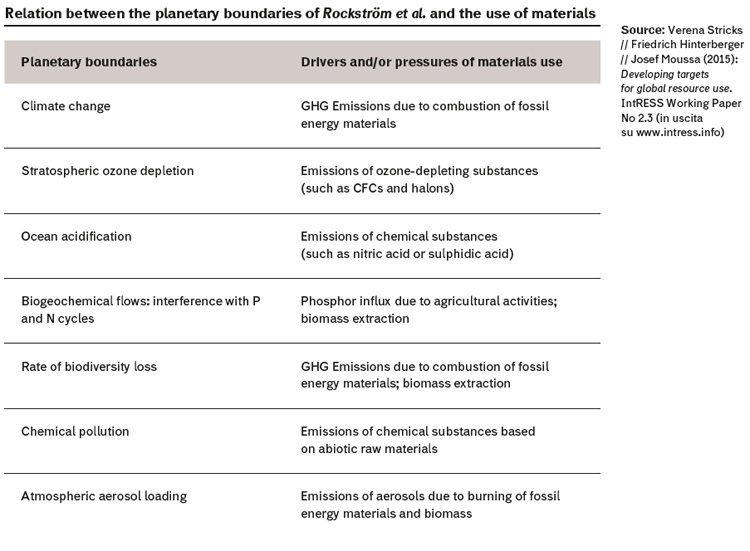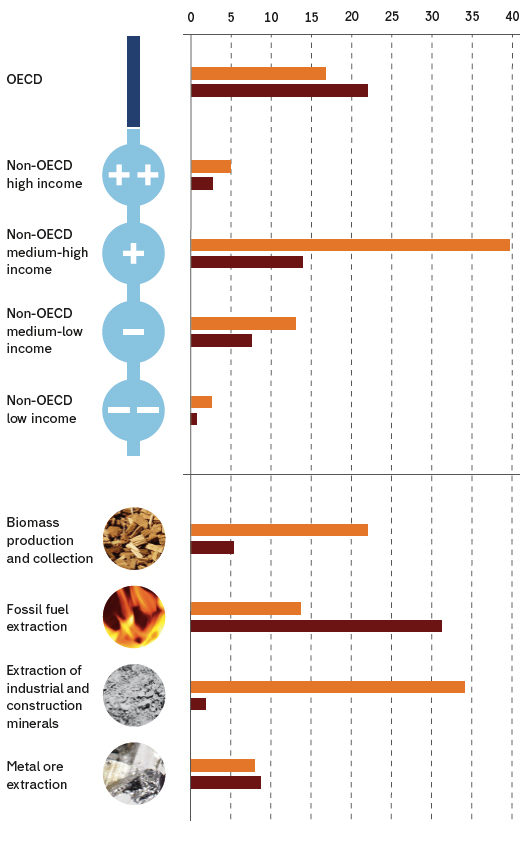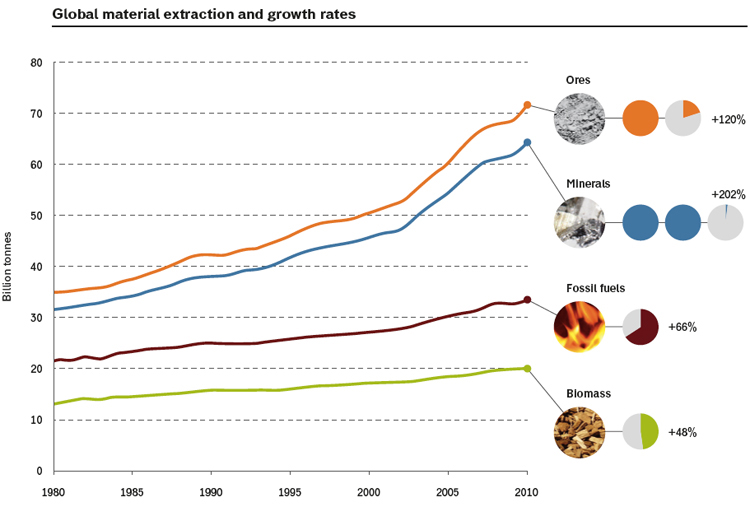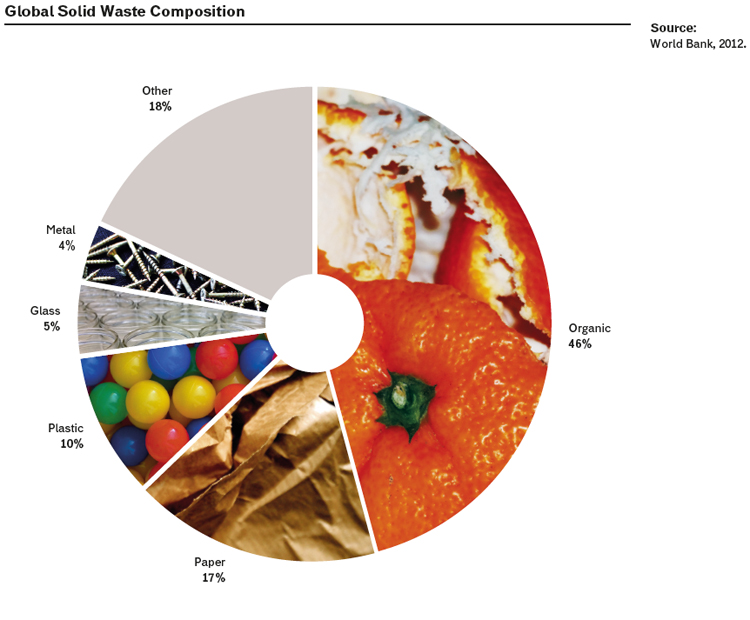The surface of the Earth has always been in slow but constant movement: excavated by waterways and glaciers, eroded by winds, upset by mountain formation and volcanic eruptions, subjected to changes in vegetation and climate. From the 20th century onwards though, a new force of nature has appeared: the action of the human species. For the amount of materials that they use, human beings are now competing with all the most important causes of geomorphological change. Every year, human beings mobilize between 50 and 60 billion tons of rocks, stones, sand and gravel (including residues). About a third of these are used in the extraction of minerals for the metal industry and two thirds are used in other industries and construction. This amount is double what ocean volcanoes erupt, triple what all the world’s rivers bring to sea, quadruple what mountain formation moves, twelve times what glaciers transport and sixty times what winds erode.
The involuntary soil movement caused by human action is even bigger, in particular that linked to erosion caused by agriculture: 80 billion tons.
Our thirst for fossil fuels translates into a yearly extraction of 45 billion tons of dormant matter of which only 14 billion are actually used as fuels. Human appropriation of biomasses has reached 27 billion tons, of which 5.5 billion are not used.
In the processes of production and consumption these materials are refined, combined, mixed with water and atmospheric elements. Water consumption at a global level has been quantified: it amounts to at least 4,000 cubic km. As far as the inputs from the atmosphere are concerned, the amount of oxygen, nitrogen and other used elements can be estimated at 30 billion tons at least.
These huge amounts define the material perimeter of our relationship with nature. Their measurement – although in many cases extremely approximate – helps us understand how much matter is put in circulation every year by human activity to produce food, to fuel industries, and to redesign territory according to our needs.
The downside of the extraction of these huge amounts of materials is their “consumption”, their progressive transformation into residues that go back into the environment or are accumulated in landfills. According to the different use and management of materials, an extracted material can transform into a residue immediately or after millennia, but inevitably, sooner or later, every used resource will be transformed into residue, with all the consequences in terms of natural equilibrium. Seven of the nine planetary boundaries identified by Rockström et al. are easily related to the use of materials.

A Huge Thirst for Materials, but What Do We Do With Them?
It is practically impossible to follow all the innumerable rivulets in which the flow of materials decomposes, recomposes, and turns into itself to end up who knows when, where and in which form, in the current immense sea of residues of human origin accumulated in the soil, water and atmosphere. Gathering reliable global data is also difficult, not only on minor flows or those considered less important, but also on big and qualitatively important flows such as waste flow. However, it is extremely important to acquire an approximate idea of all these figures. It is important for the economy and the environment, as in both cases they help us understand the magnitude of the problems we are facing and the resources available to help us resolve these problems.


So where do the materials we extract end up? The shorter supply chains are those of unused materials, those extracted only in relation to used material and that immediately become waste:
- 5.5 billion tons of biomasses, of which 0.7 in Europe (80 million tons in Italy): they are partly left in the soil, to regenerate its fertility, partly burnt, partly collected and disposed of. They are attracting ever more interest from the energy industry and the growing industry of biobased products;
- 42 billion tons of materials (gossans, drillings, excavations, residues of first selection...), of which 10% extracted in Europe (60 million tons in Italy), considered unfit for use, or non convenient, for example in construction works.
Of the 14 billion tons of extracted useful energy minerals (0.8 billion in Europe), the majority is refined and then burnt, generating 32 billion tones of CO2 and 140 million tons of methane per year, to which we need to add the products of the combustion of residual impurities. Up to 15% of oil becomes bitumen or sulphur. A percentage of fossil fuels is used to produce the 265 million tons of plastics produced globally every year. With the remaining part, solvents and all sorts of chemical products are made.
Most of the almost 22 billion tons of produced useful biomasses (2.7 billion tons in Europe and about 110 million in Italy) is made up of food for humans (8 billion tons) or for animals (11 billion tons). Forests provide 2.5 billion tons of wood and other products. The majority of biomasses end up in the atmosphere – either digested or burnt. A part however goes to wastewaters, and into waste. Food waste is estimated by FAO to be at least a third of the biomasses fit for human nutrition. Organic residues are often recovered from wastewaters as mud for depuration, which in turn ends up in landfills, or are destined to agricultural use or to incinerators.
Extracted useful metal ore amounts to almost 8 billion tons. Of these, only 170 million tons are extracted in the EU-27, the area where half a billion tons of metal concentrates and products are imported and from which 420 million tons of these manufactured products leave for the rest of the world. The balance – 250 million tons – is transformed on European soil into waste (often hazardous) and durable goods.

The Atmosphere: Our Global Dustbin
Let’s now observe the flows of global materials according to a “final destination” perspective. The atmosphere clearly appears as the most exploited global dustbin. Considering only the carbon contained in the emissions by fossil combustion and in cement production, in 2013 the annual flow has reached almost 10 billion tons, equivalent to 36 billion tons of CO2. To this figure we need to add: 1.5 billion tons of other gases – be they greenhouse gases or not; volatile substances and particulate; 3.5 billion tons from biomass combustion (most of the collected wood, part of agricultural residues); a similar amount coming from breathing of humans and animals (digestion transforms ingested food biomasses into CO2 and methane).
A very recent study by the National Center for Atmospheric Research in Colorado has estimated that the disposal of almost a billion tons of waste happens through combustion in production sites (620 million tons) and storing sites (350 million tons). The product of this combustion contributes to the saturation of the atmosphere.
The production of solid waste is mainly an urban phenomenon. According to a 2012 study by the World Bank, urban solid waste generated yearly in cities across the world amounts to 1.3 billion tons, while the International Solid Waste Association, which also takes into account the non-urban population, presents a figure of 1.84 billion tons. Next figure shows the composition of the waste analyzed in the above mentioned World Bank study.
These figures do not include a big part of industrial waste, in particular the residues of mineral extraction, as well as the unused part of cultivated or gathered biomasses. Referring to 2001, OECD (63% of world GDP) estimated that the total waste production in its member states amounted to 4 billion tons. UNEP, in a 2011 report, presented a figure of 11.2 million tons of solid waste collected at a global level.

According to some estimates, 20% of solid waste is generated in the textile sector. Electronic waste instead “only” amounts to 50 million tons, but it presents a specific level of danger, in addition to scarce recovery opportunities.
Finally, all that is not given back to nature stays within the anthropic system in the form of infrastructures, buildings, machinery, durable goods. Among the latter we find: a percentage of the billion tons of processing wood which is extracted annually; oil derivatives such as bitumen and plastics; most of the 34 billion tons of minerals extracted every year for use in construction or industrial activities; the result of the processing of the 8 billion tons of metal ore.
Obviously, the global estimates presented here are not totally exact or exempt from errors (mainly uncompleted data) and from the effect of divergent approaches between different authors and different sources. However, the type of analyses presented here (with all its limits related to global data) are of fundamental importance in understanding how the concept of matter renewability can contribute to overcome the problems related to the use of material resources. A rational management of a huge quantity of existing products and matter stored in infrastructures, buildings and durable goods that are not useful anymore, will certainly be important in reducing metal extraction, excavation of inert materials, deforestation, cultivation on overexploited land, the search for new hydrocarbon deposits and polluting productions.
Up to what point? For what materials and supply chains? At what geographical level? It is impossible to state it in general terms. More thorough and specific analyses will be useful tools in the search for answers, answers which cannot be provided only on the basis of the amounts given, but that certainly have to take them into account.
Illustration by ©Bazzier / Shuttersock
Bibliography
- Global carbon budget 2014: http://www.globalcarbonproject.org/carbonbudget/14/presentation.htm
- Biomasses combustion: https://engineering.stanford.edu/news/stanford-engineers-study-shows-effects-biomass-burning-climate-health and http://www.fao.org/ag/againfo/programmes/en/lead/toolbox/indust/bioburea.htm
- Waste: http://siteresources.worldbank.org/INTURBANDEVELOPMENT/Resources/336387-1334852610766/What_a_Waste2012_Final.pdf
- Plastics: http://www.unep.org/ietc/OurWork/WasteManagement/Projects/wastePlasticsProject/tabid/79203/Default.aspx
- I. Douglas, “Land use: the geomorphic and land use impacts of mining”, Sustainable mining practices – a global perspective, ed. V. Rajaram, S. Dutta, K. Parameswaran, 60-80, Balkema, Leiden, 2005
- H. Haberl et al., “Quantifying and mapping the human appropriation of net primary production in earth’s terrestrial ecosystems”, Proceedings of the National Academy of Sciences, v. 104, n. 31, 2007, p. 12,942-12,947
- R. LeB. Hooke, “On the history of Humans as geomorphic agents”, Geology, 28(9), 2000, pp. 843-846
- M.L. Imhoff et al., “Global patterns in human consumption of net primary production”, Nature, v. 429, 2004, pp. 870-873
- J.R. McNeill, Something New Under the Sun – An Environmental History of the Twentieth-Century World, W. W. Norton & Company, New York 2001
- S.J. Price et al., “Humans as major geological and geomorphological agents in the Anthropocene: the significance of artificial ground in Great Britain”, Philosophical Transactions A, v. 369, 2011, p. 1056-1084
- J. Rockström et al., Water Resilience for Human Prosperity, Cambridge University Press, 2014
- P.M. Vitousek (1986), “Human appropriation of the products of photosynthesis”, BioScience, v. 36, p. 368-373


